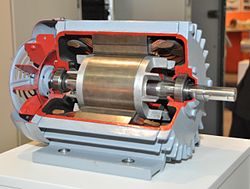A three phase induction motor is a type of electric motor widely used for various industrial and commercial applications. It operates based on the principles of electromagnetic induction, where a rotating magnetic field is generated in the motor, causing the rotor (the moving part of the motor) to rotate. Three-phase induction motors are efficient, reliable, and well-suited for heavy-duty operations.

Key components and operation of a three phase induction motor
- Stator: The stator is the stationary part of the motor and consists of three sets of windings, each connected to a different phase of a three-phase AC power supply. These windings create a rotating magnetic field when supplied with alternating current.
- Rotor: The rotor is the rotating part of the motor and is made up of conductive bars or coils. It is positioned within the stator’s magnetic field. As the magnetic field changes direction, induced currents are generated in the rotor, creating a magnetic field of its own.
- Principle of Operation:
- When three-phase AC power is supplied to the stator windings, a rotating magnetic field is created. The direction of rotation of the field changes with the alternating current.
- The rotating magnetic field induces a current in the rotor conductors through electromagnetic induction. The induced current generates its own magnetic field, which interacts with the stator’s magnetic field.
- The interaction between the rotating magnetic field and the rotor’s magnetic field causes a torque to be produced on the rotor. This torque causes the rotor to start rotating, following the direction of the rotating magnetic field.
- Synchronous Speed: The speed at which the rotating magnetic field travels is called the synchronous speed and is determined by the frequency of the AC power supply and the number of poles in the stator windings. The formula for synchronous speed (Ns) is given by: Ns = (120 * f) / P, where f is the frequency in Hertz and P is the number of poles.
- Slip: In reality, the rotor never reaches the synchronous speed due to factors like friction and losses. The difference between the synchronous speed and the actual rotor speed is called slip (S). Slip is given by: S = (Ns – N) / Ns, where N is the actual rotor speed.
Three-phase induction motors are categorized into two main types based on the rotor construction: squirrel-cage and wound-rotor motors. Squirrel-cage motors have a simple rotor design with bars short-circuited at the ends, while wound-rotor motors have a rotor with separate windings externally connected to slip rings.
Three-phase induction motors offer advantages such as high efficiency, ruggedness, low maintenance, and the ability to operate in a wide range of conditions. They are commonly used in industries like manufacturing, transportation, agriculture, and more.